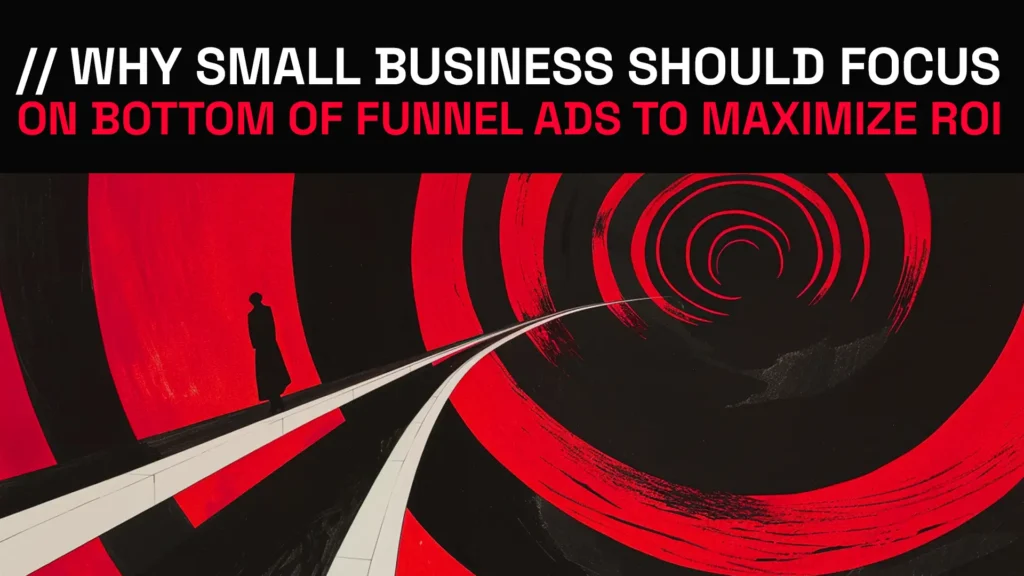TAKE YOUR BUSINESS TO THE NEXT LEVEL
Let us take marketing off your plate. Visit our pricing to learn more about working with Next Level.

Small businesses often face the challenge of having to make the most of limited marketing budgets. With finite resources and audience sizes, it’s crucial that every advertising dollar generates maximum return on investment (ROI). This is where bottom of funnel ads come into play. By targeting prospects who are already in the decision-making stage of the buyer’s journey, small businesses can get the most bang for their buck.
Imagine you own a small bakery. You have a modest advertising budget that allows you to either put up a billboard along a busy highway or run targeted Google Search Ads. The billboard will be seen by thousands of people, but how many are actually looking to buy baked goods at that moment? Likely very few. In contrast, the search ads will only be shown to people actively searching for terms like “bakery near me” or “fresh baked cookies.” These are high-intent audiences ready to make a purchase. By laser-focusing your limited budget on bottom of funnel prospects, you’re fishing in a barrel packed with hungry fish instead of casting a wide net in the open ocean and hoping for a bite.
Multiple studies have shown that consumers exposed to bottom of funnel ads are more likely to complete a purchase compared to those who see upper funnel ads. For example, a Google study found that display ads shown to in-market shoppers had a 10x higher CTR compared to ads shown to general audiences. For small businesses with restricted budgets, prioritizing spend on prospects with high purchase intent is the most efficient path to revenue.
Small businesses often struggle to match the ad spend of larger competitors. Fortunately, they can use bottom of funnel targeting to level the playing field. Think of it like a game of chess. You may command fewer and smaller pieces, but you can still outmaneuver your opponent by playing smartly and precisely.
For instance, a small independent bookstore likely can’t outbid Amazon on broad keywords like “books” or “novels.” But by targeting long-tail keywords indicating high purchase intent such as “buy used crime thriller books,” they limit competition and make the most of a smaller budget.
An analysis by Ahrefs found that long-tail keywords with lower search volumes have significantly higher click-through rates compared to broad, highly competitive keywords. Prioritizing such bottom of funnel keywords allows small advertisers to avoid bidding wars with deep-pocketed competitors. Much like a lightweight boxer defeating a heavyweight by being nimble and precise, small businesses can outmaneuver larger rivals by dominating niche bottom of funnel segments.

A major advantage of bottom of funnel advertising is that it minimizes wasted ad spend. After all, you want your limited budget focused on prospects likely to convert, not tire-kickers who consume your ad dollars without generating revenue. It’s the difference between taking only well-aimed shots versus firing indiscriminately and hoping to hit the target.
Consider a local landscaping business. By running search ads targeting transactional keywords like “landscapers in [city]” or “landscaping services near me”, they ensure that ad spend is focused on potential customers with immediate purchase intent. Contrast that with an upper funnel Facebook ad targeting a broad audience of local homeowners. Many who see the ad may have a general interest in landscaping but no immediate need for services, leading to inefficient spend. One study found that search ads convert 1.5x better than social media ads on average. For small businesses with strict budgets, minimizing inefficient ad spend is paramount. Bottom of funnel ads accomplish exactly that.
Another highly effective bottom of funnel tactic for small businesses is retargeting. This involves serving ads to prospects who have previously interacted with your business, such as by visiting your website. These individuals have already expressed purchase intent through their prior engagement, making them prime candidates for conversion.
Imagine you sell handcrafted furniture and a prospect visits a product page on your site but leaves without buying. By retargeting them with ads featuring the specific product they viewed or offering a discount code, you capitalize on their initial interest and guide them towards a purchase. Studies have found that retargeting ads can boost conversion rates by up to 150% compared to standard display ads.Much like a savvy salesperson following up with an interested lead, retargeting allows you to keep your brand and offerings top of mind for bottom of funnel prospects.
Small businesses can stretch their budgets further by focusing retargeting efforts on prospects who have shown the highest intent, such as cart abandoners. With limited audience sizes, identifying and re-engaging those most likely to convert maximizes efficiency. Rather than paying to continually reach broad, unqualified audiences, small businesses can allocate budgets towards retargeting the ripest opportunities.
For any small business investing in advertising, it’s essential to diligently track performance and optimize for profitability. This is especially true for bottom of funnel campaigns, where the goal is driving revenue as efficiently as possible.
Think of it like tending a garden. You can’t just plant the seeds and hope for the best. You need to continually monitor the health of your crops, taking note of key indicators and making adjustments as needed to maximize your yield. For bottom of funnel campaigns, the most important metrics are cost per acquisition (CPA) and return on ad spend (ROAS). By keeping a close eye on these figures, small businesses can ensure their limited budgets are consistently generating positive ROI.

In the earlier example of the local bakery, imagine their initial search campaigns have an avg CPA of $8 against an avg order value of $20. That’s a solid ROAS of 2.5. However, by reviewing the search term report, they may uncover an even more profitable keyword – “custom birthday cake delivery” – that has an avg CPA of $15 but avg order value of $50. By shifting more budget towards the higher-performing “birthday cake” keywords and reducing spend on broader “bakery” terms, they can boost overall profitability. Tactics like this allow small advertisers to progressively hone their bottom of funnel campaigns into highly efficient revenue drivers.
For small businesses aiming to maximize revenue and profitability, bottom of funnel advertising is unequivocally the most effective approach. By focusing limited budgets on high-intent audiences, outmaneuvering competitors in niche segments, and diligently optimizing for ROI, small advertisers can generate outsized returns. As the digital ad landscape grows increasingly competitive, those who master the art of bottom of funnel advertising will be best positioned to thrive. In the eternal chess match of business, precision targeting is the ultimate trump card.
Let us take marketing off your plate. Visit our pricing to learn more about working with Next Level.